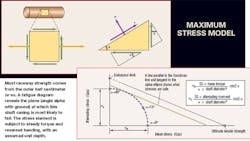MSD 101: Shaft raceways
Because shafts provide the inner raceways for all linear bearings, theirs is often lumped into bearing design as an afterthought. But bearing raceway sections on shafts are very critical because some (if not most) bearing failures actually result from shaft problems; variances translate through bearings to surrounding equipment. Carefully considering shaft dimensions, surface finishes, and hardness improves uniform load distribution, improved system accuracy, and life.
Q: How should surface hardness be specified?
A: Tolerances don’t mean much if they don’t last. Two things — magnitude and depth — determine the extent to which hardening extends life. To maximize benefits, evenness is paramount. Sudden hardness drop-offs at shallow depths can cause surfaces to become brittle and wear prematurely. Dropoffs deeper in the material minimize the positive effects of hardening. At the very least, raceway areas should be surface hardened with reasonable core strength for full bearing capacity. Steels high in sulfur or lead are not acceptable. Oil holes are okay in raceway areas, but edges should be gently blended.
Q: How can dimension affect performance?
A: Shafts must be of sufficient size to keep operating deflections within limits. Out-ofroundness shouldn’t exceed 0.0025 mm for diameters to 25 mm. Above that, as a ballpark figure, allowable radial deviation can equal raceway diameter divided by 25, plus 0.0025 mm.
For effective shaft/bearing assembly, the end of the shaft should have the larger chamfer. This prevents roller complement damage and raceway surface scratching.
Q: How does surface finish factor in?
A: Grinding within a consistent range makes for more consistent loading (benefiting roller element bearings) because rolling surfaces have increased contact with the shaft. Polishing makes for decreased wear particulate generation, which is required for many clean room applications. It also removes microscopic peaks from shaft surfaces to reduce drag (benefiting plane bearings with less binding.)
Improper shaft finishes keep bearings from gripping correctly. Without the proper contact between bearing and shaft, rings tend to creep, wear, and cause corrosion. Wear (metal-to-metal rubbing) contributes to early bearing failure. Another problem stems from grind reliefs and fillets extending into a shaft’s raceway area. These sites often invite early failure especially if the rollers overhang them, causing high stress concentrations. (As a general rule of thumb, raceway finishes should not exceed 0.2 μm on the Ra scale.) Another point to remember: Sometimes bearing contact seals operate on surfaces ground for bearing raceways. Here, subtle shaft finish patterns can make trouble; a spiraled finish (for example, from through-fed centerless grinding) may pump lubricant past seals.
